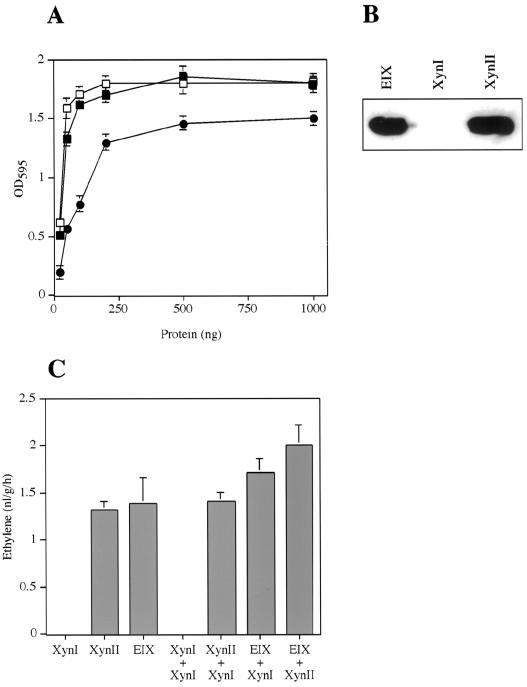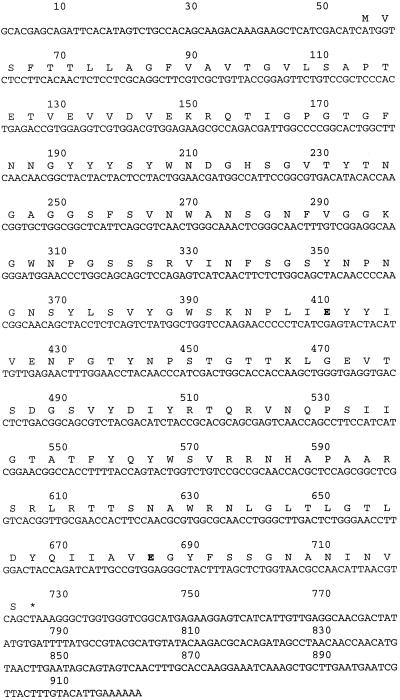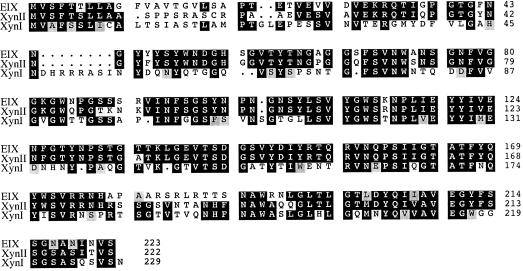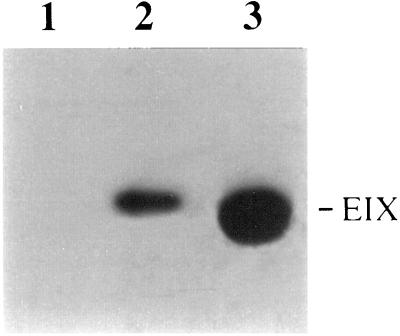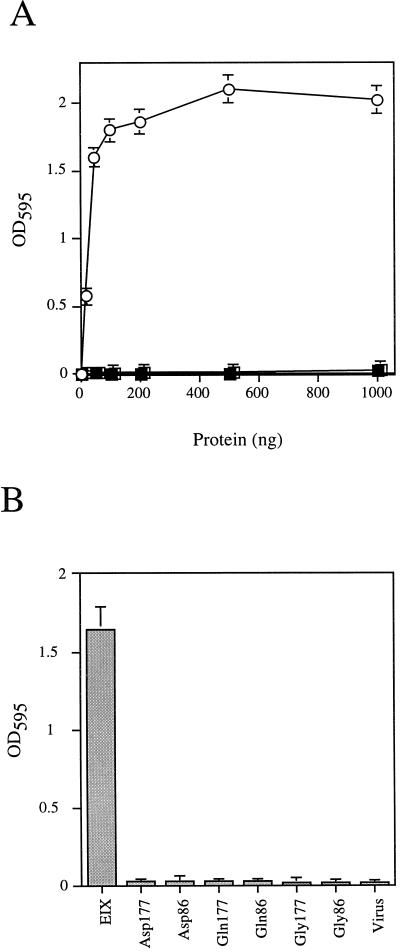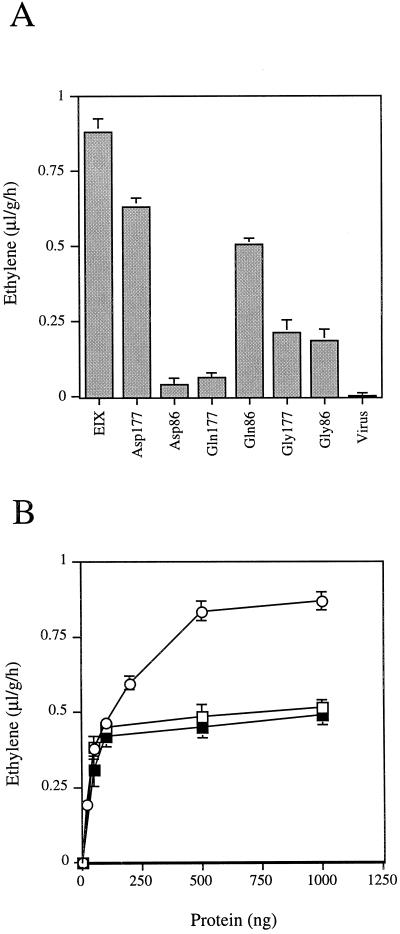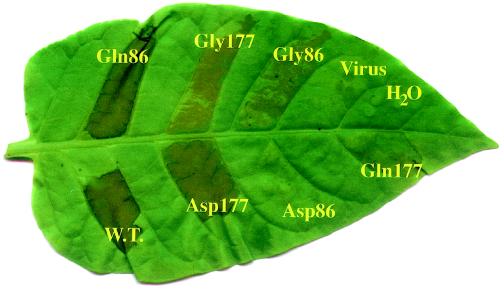Abstract
Ethylene-inducing xylanase (EIX) elicits plant defense responses in certain tobacco (Nicotiana tabacum) and tomato cultivars in addition to its xylan degradation activity. It is not clear, however, whether elicitation occurs by cell wall fragments released by the enzymatic activity or by the xylanase protein interacting directly with the plant cells. We cloned the gene encoding EIX protein and overexpressed it in insect cells. To determine the relationship between the two activities, substitution of amino acids in the xylanase active site was performed. Substitution at glutamic acid-86 or -177 with glutamine (Gln), aspartic acid (Asp), or glycine (Gly) inhibited the β-1-4-endoxylanase activity. Mutants having Asp-86 or Gln-177 also lost the ability to induce the hypersensitive response and ethylene biosynthesis. However, mutants having Gln-86, Gly-86, Asp-177, or Gly-177 retained ability to induce ethylene biosynthesis and the hypersensitive response. Our data show that the xylanase activity of EIX elicitor can be separated from the elicitation process, as some of the mutants lack the former but retain the latter.
Pathogens secrete polysaccharide-cleaving enzymes to penetrate the plant cell during infection (Cooper et al., 1988; Xu and Mendgen, 1997). There is evidence that endo-β-1,4-xylanases that cleave the β-1,4 linkage of the xylosyl backbone play a role in pathogenicity (Ishii, 1988; Walton, 1994; Wu et al., 1997). Proteinaceous elicitors exhibiting hydrolytic activity have been isolated from different fungi. It was suggested that different cell wall constituents, originating either from the host plant or the invading pathogen, can induce the plant defense responses (Walker-Simmons et al., 1984; Hahn et al., 1989; Bucheli et al., 1990; Cheong and Hahn, 1991).
A 22-kD fungal protein (β-1-4-endoxylanase) referred to as ethylene-inducing xylanase (EIX), has been isolated from xylan-induced Trichoderma viride cultures (Fuchs et al., 1989; Dean et al., 1991). Similar xylanases have been identified in xylan-induced filtrates of plant pathogenic fungi (Dean et al., 1989; Wu et al., 1997). When applied to cut roots or petioles, EIX is translocated in the xylem tissues and induces symptoms in leaves both above and below the point of EIX application (Bailey et al., 1991; Sharon et al., 1992). Injection of EIX into the leaf-mesophyll intercellular spaces induces ethylene production and cell death, as well as other plant defense responses in the tobacco (Nicotiana tabacum) cv Xanthi (Bailey et al., 1990, 1992; Lotan and Fluhr, 1990), in tomato leaf tissue (Avni et al., 1994a), and in cell suspensions (Bailey et al., 1992; Felix et al., 1993; Yano et al., 1998). These are characteristic responses of plants to exogenously applied elicitors (Keen et al., 1990; Blein et al., 1991; Felix et al., 1993).
EIX induces the plant defense responses only in certain plant species (Bailey et al., 1993, 1995; Avni et al., 1994b; Yano et al., 1998). The interaction between EIX and plants has been shown to follow the gene-for-gene model (Flor, 1971). The tomato cv M82 responds to EIX treatment, while an isogenic line, cv IL75, does not (Avni et al., 1994a). Therefore, it was hypothesized that the elicitor activity of EIX might be unrelated to the xylan-degrading activity (Sharon et al., 1993). In the present study we used a molecular approach to show that the elicitation of ethylene biosynthesis and the hypersensitive response (HR) can be separated from the endoxylanase activity of this protein.
MATERIALS AND METHODS
Plant Material and Tissue Treatment
Tobacco (Nicotiana tabacum L. cv Xanthi) plants were grown under greenhouse conditions until they were 25 to 35 cm tall. Young, fully expanded leaves were cut and incubated for 14 h in an atmosphere containing 120 μL/L ethylene to make them more responsive to EIX. EIX was applied to leaf discs prepared from ethylene-treated leaves (1 cm in diameter) as previously described (Avni et al., 1994b). Ethylene production was measured by GC after sealing 25-mL flasks containing leaf discs (six per flask, average total weight 85 mg) for 4 h (Avni et al., 1994b). Alternatively, EIX (1 μg/mL) was injected into leaf tissue and development of cell death was analyzed after 96 h (Bailey et al., 1990).
Endo-1,4-β-Xylanase Assay
Xylanase activity was determined as described by Biely et al. (1985). Enzyme activity was determined with 5.75 mg/mL Remazol Brilliant Blue Xylan (Sigma, St. Louis) in 0.05 m acetate buffer (pH 5.4) at 30°C for 90 min. The reaction was terminated by the addition of 2 volumes of 96% (v/v) ethanol. Insoluble material was removed by centrifugation at 2,000g for 5 min. The absorbency of the supernatant was measured at 595 nm.
Isolation of the EIX Gene
Two degenerate primers, AT[GT]GG[CT]CC[AG]GG[CT]AC[TC]GG[CT]TT[TC]AACAACGG corresponding to residues 34 to 44 of the coding strand and GACCA[AG]TA[TC]TG[AG]TA[AG]AA[AG]GT[TA]GC[AG]GT corresponding to residues 133 to 141 of the noncoding strand of the EIX protein (Dean et al., 1994), were used to amplify a 320-bp EIX gene fragment from a Trichoderma viride cDNA, using PCR. This fragment was used as a probe to screen a T. viride cDNA library constructed in Lambda ZAP II (Stratagene, La Jolla, CA). Screening was performed by standard procedures (Sambrook et al., 1989).
Construction of Recombinant Baculovirus
The ORF of the EIX gene was amplified with the primers CATCGGATCCATGGTCTCCTTCAC and GTCGGAGCTCCAACAATGATGACTCC to generate BamHI-SacI sites. The ORF was cloned into the BamHI-SaclI sites of a baculovirus transfer vector (pFastBac1, Gibco-BRL, Cleveland). Recombinant baculoviruses were generated by using the Bac-to-Bac system (Gibco-BRL) based on targeted transposition of the expression cassette to the baculovirus genome maintained in Escherichia coli as a bacmid (Luckow et al., 1993). The resulting recombinant bacmids were used to transfect Spodoptera frugiperda (Sf9) cells using Cellfectin (Gibco-BRL), and the presence of recombinant virus was verified 3 to 4 d after the transfection by immunoblotting using EIX antibody. The amplified virus stocks were generated according to standard protocols (O'Reilly and Miller, 1989) and used to infect sf9 insect cells growing in 25-cm2 tissue culture flasks. The cells were harvested 3 to 4 d post infection.
Modifying the EIX Gene
Site-directed mutagenesis was performed as described by Kunkel (1985). In vitro mutagenesis was performed on single-stranded DNA isolated from pBS-KS (Stratagene) vector harboring the EIX gene using two different sets of oligonucleotides: 5′-AACCCATTAATCXXXTACTAC-3′ (to generate mutations at codon 86 of EIX) and 5′-ATCATTGCCGTGXXXGGCTAC-3′ (to generate mutations at codon 177 of EIX). XXX refers to: Asp change GAC; Gln change CAC; Gly change GGA. The mutations were confirmed by sequencing.
RESULTS AND DISCUSSION
Induction of Ethylene Biosynthesis by Different Xylanases
The enzymatic activity (β-1-4-endoxylanase) of EIX was compared with the enzymatic activity of XynI and XynII isolated from Trichoderma reesei (Torronen et al., 1992). EIX and XynII had similar enzymatic activity, while XynI was less active (Fig. 1A; Torronen et al., 1992). XynII, but not XynI, cross-reacted with antibodies raised against EIX (Fig. 1B). The abilities of EIX, XynII, and XynI to induce ethylene biosynthesis was compared. EIX and XynII but not XynI induced ethylene biosynthesis in tobacco leaves (Fig. 1C). When EIX was mixed with XynII, ethylene biosynthesis was enhanced. However, when EIX or XynII was mixed with XynI, ethylene biosynthesis levels were similar to those induced by EIX or XynII alone. Moreover, doubling the amount of XynI did not induce ethylene biosynthesis (Fig. 1C). These data show that the addition of an enzyme (XynI) with similar enzymatic activity as EIX or XynII does not influence the induction of ethylene biosynthesis by EIX or XynII. Thus, the xylanase activity of EIX appears to be unrelated to the elicitation process. However, differences in substrate specificity between XynI and EIX may exist. There is also the possibility that the difference in enzyme specificity may account for the inability of XynI to induce ethylene induction. Therefore, we chose the molecular approach to separate the two activities.
Figure 1.
Activity of the xylanase proteins. A, β-1-4-Endoxylanase activity of EIX (□) from T. viride and XynI (●) and XynII (▪) from T. reesei. Enzymatic activity was determined as described in “Materials and Methods.” B, Fifty nanograms of EIX, XynI, and XynII proteins was separated on a 15% (w/v) SDS-polyacrylamide gel, transferred to a nitrocellulose filter, and probed with anti-EIX antibodies. C, Ethylene induction was performed with 0.5 μg of each designated protein as described in “Material and Methods.”
Isolating the Gene Coding for EIX from T. viride
The EIX protein has been isolated from T. viride and a partial amino acid sequence determined (Dean et al., 1994). Genes for two xylanases have been cloned from T. reesei (Torronen et al., 1992). We used degenerate primers in a PCR reaction to amplify a 320-bp DNA fragment representing part of the T. viride EIX gene. The deduced amino acid sequence of part of the 320-bp fragment showed over 90% identity to the partial amino acid sequence of the T. viride xylanase and 79% identity to XynII from T. reesei (data not shown). A full-length cDNA clone of EIX was isolated from a T. viride cDNA library designated Tvx. It contained a 672-bp coding region, a 55-bp 5′ UTR, and a 190-bp 3′ UTR (Fig. 2). The coding region of EIX contains a 32-amino acid signal peptide (determined by homology to other xylanases) responsible for the secretion of the EIX protein from the cells into the growth medium. Additionally, the deduced amino acid sequence of Tvx and XynII from T. reesei are 80% identical, while there is only 50% identity with the XynI protein (Fig. 3).
Figure 2.
Nucleotide sequence of the Tvx gene. The 960-bp full-length tveix cDNA (accession no. AJ012717) clone was sequenced by the dideoxy chain termination method. The deduced amino acid sequence is shown above the nucleotide sequence. Amino acids Glu-86 and Glu-177 of the mature protein, subjected to site-directed mutagenesis, are indicated in bold.
Figure 3.
Similarity of EIX, XynII, and XynI. Alignment of the deduced amino acid sequences of XynII and XynI (Torronen et al., 1992) with that of TvX was according to the PileUp and PrettyBox sequence analysis software programs (version 10, Genetics Computer Group, Madison, WI). Single-letter codons are used for amino acid residues, black or gray boxes indicate identical or similar residues, and dots indicate gaps introduced to allow optimal alignment of the sequence.
Modifying the EIX Protein
The mechanisms underlying elicitor perception at the plant cell surface are still not well understood. Nurnberger et al. (1994) showed that an oligopeptide of 13 amino acids from a 42-kD glycoprotein elicitor from P. megasperma binds to plant membranes and can stimulate a complex defense response in parsley cells. To define the epitope necessary for inducing the plant defense response, we expressed the EIX protein in a baculovirus expression system. The EIX ORF was cloned behind the strong polyhedron promoter of the baculovirus, and the protein was expressed in sf9 insect cells. Immunoblots were used to identify the overexpressed EIX protein in the sf9 cells (Fig. 4). The two biological activities of the overexpressed protein, xylanase activity (Table I; β-1-4-endoxylanase) and the induction of ethylene biosynthesis in tobacco (Table I). We found that the baculovirus-expressed protein maintained the same level of activity as the protein isolated from T. viride.
Figure 4.
Expression of EIX in sf9 cells. Sf9 cells were infected with baculovirus (lane 1) or baculovirus harboring the Tvx gene (lane 2). Crude lysate and pure EIX (lane 3) proteins were separated on a 15% (w/v) SDS-polyacrylamide gel, transferred to a nitrocellulose filter, and probed with anti-EIX antibodies.
Table I.
Biological activity of EIX expressed in sf9 cells
| Elicitor | Ethylene Productiona | Xylanase Activityb |
|---|---|---|
| μL h−1 g−1 | ||
| EIX | 0.475 ± 0.015 | 1.9 ± 0.11 |
| EIX-Bacc | 0.455 ± 0.016 | 2.0 ± 0.05 |
| Control | 0.027 ± 0.005 | 0.02 ± 0.001 |
One microgram of EIX protein or 10 μg of sf9 cell lysate was used as a control.
Xylanase activity was measured according to the method of Biely et al. (1985). The xylanase activity is shown as OD595. Two-hundred nanograms EIX- or sf9-expressed EIX (the amount of EIX in the sf9 lysate was monitored by immunoblot) was used for the xylanase activity and 1,000 ng of the sf9 cell lysate was used as control.
EIX-Bac, Wild-type EIX expressed in sf9 cells by recombinant baculovirus.
Two amino acids at the active site, Glu-86 and Glu-177 of the XynII protein from T. reesei, were previously found to be essential for the enzymatic activity (Torronen et al., 1992). Similar amino acids exist in similar positions in the mature EIX protein isolated from T. viride. We performed single-substitution mutations involving these two amino acids (amino acids Glu-86 and Glu-177 are indicated in Fig. 2) by site-directed mutagenesis and expressed the mutated proteins in the baculovirus expression system. Glu-86 was changed to Asp-86, Gln-86, or Gly-86, while Glu-177 was changed to Asp-177, Gln-177, or Gly-177. Similar amounts of overexpressed mutated proteins as determined by immunoblots (data not shown) were used to test the xylanase and elicitor activities.
We analyzed the xylanase activity of the mutant proteins. The xylanase activity of EIX reached saturation when using 100 ng/mL EIX protein (Fig. 5A), while the enzymatic activity of mutants Gln-86 and Asp-177 showed no activity even at a concentration of 1,000 ng/mL. Further analysis showed that all of the mutated proteins lost their xylanase activity (Fig. 5B). These results strongly support the data by Torronen et al. (1994) that Glu-86 and Glu-177 are essential for xylanase activity. The ethylene induction activity of mutants Gln-86 and Asp-177 was more than 50% of the EIX (Fig. 6A), while mutants Gly-86 and Gly-177 displayed about 20% and mutants Asp-86 and Gln-177 displayed about 10% of the EIX activity (Fig. 6A). A dose-response assay showed that the mutant proteins Gln-86 and Asp-177 retained their elicitation activity (Fig. 6B). The induction pattern of the two mutants was similar to that of the EIX protein (Fig. 6B).
Figure 5.
Xylanase activity of the sf9-expressed EIX proteins. A, β-1-4-Endoxylanase activity of different amounts of EIX (○) and the mutated proteins Gln-86 (□) and Asp-177 (▪). Enzymatic activity was performed as described in “Materials and Methods.” B, β-1-4-Endoxylanase activity of EIX and mutated proteins. For each assay 200 ng of the respective protein were used. Enzymatic activity was measured as described in “Materials and Methods.” Virus, Total sf9 protein lysate infected with wild-type baculovirus.
Figure 6.
Ethylene induction activity of the sf9 expressed EIX proteins. A, Six tobacco leaf discs were treated with EIX (1 μg/mL) or with the mutated proteins (1 μg/mL) for 4 h. Ethylene production was measured by GC as described in “Materials and Methods.” B, Six leaf discs of tobacco were treated with different amounts of EIX (○) or the mutant proteins Gln-86 (□)and Asp-177 (▪) for 4 h. Ethylene production was measured by GC as described in “Materials and Methods.”
The induction of ethylene biosynthesis correlates with the ability of EIX to induce pathogenesis-related proteins and the HR (Bailey et al., 1995). Therefore, we used the induction of HR by EIX as a second assay to analyze the function of the mutated proteins. The mutated proteins were injected into tobacco leaves and the induction of HR was monitored 96 h after injection (Fig. 7). We injected six different leaves on three different plants. A representative experiment of a single leaf is shown in Figure 7. The induction of HR by the mutated proteins paralleled the amount of ethylene induction by the same mutated proteins. Mutated proteins that gave induction to a high level of ethylene induced a strong HR phenotype (Figs. 6 and 7). Thus, the protein itself is likely the elicitor molecule that induces the plant defense response.
Figure 7.
Induction of HR by expressed EIX proteins in tobacco plants. Leaves from the tobacco cv Xanthi were injected with EIX (W.T.) or with the mutated proteins (1 μg/mL). Virus, Injection of total sf9 protein lysate infected with wild-type baculovirus. Development of HR was monitored 96 h after treatment.
The two amino acids Glu-86 and Glu-177 were shown to be located in the cleft region of the protein that binds xylan (Torronen et al., 1994). We reasoned that a conserved change from Glu to Asp or Gln should not affect the overall structure of the EIX protein. However, it might influence the structure of the active site. Indeed, all of the mutant proteins lost the β-1-4-endoxylanase activity (Fig. 5), while some of them also lost the elicitation activity (Figs. 6 and 7). We speculate that the region of the active site might be also part of the EIX protein that is been recognized by the plant cells, since small changes in the active site influence the elicitation activity. Minor changes in the part of the protein that serves as the epitope site might affect its binding capability to the plant cell, thus influencing its elicitation activity. EIX has been shown to interact with components of the cell, e.g. the plasma membrane or other sites (Hanania and Avni, 1997). Our results strongly support the data by Sharon et al. (1993) showing that protoplasts, which lack wall components, respond to EIX.
ACKNOWLEDGMENTS
We thank Dr. J.D. Anderson for the EIX protein, anti-EIX antibodies, and T. viride cDNA library, and Dr. A. Torronen for providing us with T. reesei XynI and XynII proteins. We are grateful to Drs. M. Edelman, G. Kotlizky, and A. Sharon for helpful suggestions and discussions.
Footnotes
This work was supported in part by a research grant (no. 2491–95R) from The U.S.-Israel Binational Agriculture Research and Development Fund and in part by the Israel Science Foundation administrated by the Israel Academy of Science and Humanities.
LITERATURE CITED
- Avni A, Avidan N, Eshed Y, Zamir D, Bailey BA, Stommel JR, Anderson JD. The response of Lycopersicon esculentum to a fungal xylanase is controlled by a single dominant gene (abstract no. 872) Plant Physiol. 1994a;105:S-158. [Google Scholar]
- Avni A, Bailey BA, Mattoo AK, Anderson JD. Induction of ethylene biosynthesis in Nicotiana tabacum by a Trichoderma viride xylanase is correlated to the accumulation of ACC synthase and ACC oxidase. Plant Physiol. 1994b;106:1049–1055. doi: 10.1104/pp.106.3.1049. [DOI] [PMC free article] [PubMed] [Google Scholar]
- Bailey BA, Avni A, Anderson JD. The influence of ethylene and tissue age on the sensitivity of Xanthi tobacco leaves to Trichoderma viride xylanase. Plant Cell Physiol. 1995;36:1669–1676. [Google Scholar]
- Bailey BA, Dean JFD, Anderson JD. An ethylene biosynthesis-inducing endoxylanase elicits electrolyte leakage and necrosis in Nicotiana tabacum cv Xanthi leaves. Plant Physiol. 1990;94:1849–1854. doi: 10.1104/pp.94.4.1849. [DOI] [PMC free article] [PubMed] [Google Scholar]
- Bailey BA, Korcak RF, Anderson JD. Alteration in Nicotiana tabacum L. cv Xanthi cell membrane integrity following treatment with ethylene biosynthesis-inducing endoxylanase. Plant Physiol. 1992;100:749–755. doi: 10.1104/pp.100.2.749. [DOI] [PMC free article] [PubMed] [Google Scholar]
- Bailey BA, Korcak RF, Anderson JD. Sensitivity to an ethylene biosynthesis-inducing endoxylanase in Nicotiana L. cv Xanthi is controlled by a single dominant gene. Plant Physiol. 1993;101:1081–1088. doi: 10.1104/pp.101.3.1081. [DOI] [PMC free article] [PubMed] [Google Scholar]
- Bailey BA, Taylor R, Dean JFD, Anderson JD. Ethylene biosynthesis-inducing endoxylanase is translocated through the xylem of Nicotiana tabacum cv Xanthi plants. Plant Physiol. 1991;97:1181–1186. doi: 10.1104/pp.97.3.1181. [DOI] [PMC free article] [PubMed] [Google Scholar]
- Biely P, Mislovicova D, Toman R. Soluble chromogenic substrates for the assay of endo-1,4-β-xylanases and endo-1,4-β-glucanases. Anal Biochem. 1985;144:142–146. doi: 10.1016/0003-2697(85)90095-8. [DOI] [PubMed] [Google Scholar]
- Blein J-P, Milat ML, Ricci P. Responses of cultured tobacco cells to cryptogein, a proteinaceous elicitor from Phytophthora cryptogea. Plant Physiol. 1991;95:486–491. doi: 10.1104/pp.95.2.486. [DOI] [PMC free article] [PubMed] [Google Scholar]
- Bucheli P, Doares SH, Albersheim P, Darvill A. Host-pathogen interactions. XXXVI. Partial purification and characterization of heat-labile molecules secreted by the rice blast pathogen that solubilize plant cell wall fragments kill plant cells. Mol Plant Pathol. 1990;36:159–173. [Google Scholar]
- Cheong J-J, Hahn MG. A specific high affinity binding site for the hepa-β-glucoside elicitor exists in soybean membranes. Plant Cell. 1991;3:137–147. doi: 10.1105/tpc.3.2.137. [DOI] [PMC free article] [PubMed] [Google Scholar]
- Cooper RM, Longman D, Campbell A, Henry M, Lee PE. Enzymatic adaptation of cereal pathogens to the monocotyledonous primary cell wall. Physiol Mol Plant Pathol. 1988;32:33–47. [Google Scholar]
- Dean JFD, Coull JM, Anderson JD. Generation of internal amino acid sequence without peptide purification: amino acids sequencing of the ethylene biosynthesis inducing xylanase from Trichoderma viride. Protein Pept Lett. 1994;1:149–156. [Google Scholar]
- Dean JFD, Gamble HR, Anderson JD. The ethylene biosynthesis inducing xylanase: its induction in Trichoderma viride and certain plant pathogens. Phytopathology. 1989;79:1071–1078. [Google Scholar]
- Dean JFD, Gross KC, Anderson JD. Ethylene biosynthesis-inducing xylanase. III. Product characterization. Plant Physiol. 1991;96:571–576. doi: 10.1104/pp.96.2.571. [DOI] [PMC free article] [PubMed] [Google Scholar]
- Felix G, Regenass M, Boller T. Specific perception of subnanomolar concentrations of chitin fragments by tomato cells: induction of extracellular alkalization, changes in protein phosphorylation, and establishment of a refractory state. Plant J. 1993;4:307–316. [Google Scholar]
- Flor HH. Current status of the gene-for-gene concept. Annu Rev Phytopathol. 1971;9:275–296. [Google Scholar]
- Fuchs Y, Saxena A, Gamble HR, Anderson JD. Ethylene biosynthesis-inducing protein from cellulysin is an endoxylanase. Plant Physiol. 1989;89:138–143. doi: 10.1104/pp.89.1.138. [DOI] [PMC free article] [PubMed] [Google Scholar]
- Hahn MG, Bucheli P, Cervone F, Doare SH, O'Neill RA, Darvill AG, Albersheim P. Roles of cell wall constituents in plant-pathogen interactions. In: Kosuge T, Nester EW, editors. Plant-Microbe Interaction: Molecular and Genetic Perspectives. Vol. 3. New York: McGraw Hill; 1989. pp. 131–181. [Google Scholar]
- Hanania U, Avni A. High affinity binding site for ethylene inducing xylanase elicitor on Nicotiana tabacum membranes. Plant J. 1997;12:113–120. [Google Scholar]
- Ishii S. Factors influencing protoplast viability of suspension-cultured rice cells during isolation process. Plant Physiol. 1988;88:26–29. doi: 10.1104/pp.88.1.26. [DOI] [PMC free article] [PubMed] [Google Scholar]
- Keen NT, Tamaki D, Kobayashi D, Gerhold D, Stayton M, Shen H, Gold S, Lorang J, Thordal-Christensen H, Dahlbeck D, Staskawicz B. Bacteria expressing avirulence gene D produce a specific elicitor of the soybean hypersensitive reaction. Mol Plant-Microbe Interact. 1990;3:112–121. [Google Scholar]
- Kunkel TA. Rapid and efficient site-specific mutagenesis without phenotypic selection. Proc Natl Acad Sci USA. 1985;82:488–492. doi: 10.1073/pnas.82.2.488. [DOI] [PMC free article] [PubMed] [Google Scholar]
- Lotan T, Fluhr R. Xylanase, a novel elicitor of pathogenesis-related proteins in tobacco, use a non-ethylene pathway for induction. Plant Physiol. 1990;93:811–817. doi: 10.1104/pp.93.2.811. [DOI] [PMC free article] [PubMed] [Google Scholar]
- Luckow VA, Lee SC, Barry GF, Olins PO. Efficient generation of infectious recombinant baculoviruses by site-specific transposon-mediated insertion of foreign genes into a baculovirus genome propagated in Escherichia coli. J Virol. 1993;67:4566–4579. doi: 10.1128/jvi.67.8.4566-4579.1993. [DOI] [PMC free article] [PubMed] [Google Scholar]
- Nurnberger T, Nennstiel D, Jabs T, Sacks WR, Hahlbrock K, Scheel D. High affinity binding of a fungal oligopeptide elicitor to parsley plasma membranes triggers multiple defense responses. Cell. 1994;78:449–460. doi: 10.1016/0092-8674(94)90423-5. [DOI] [PubMed] [Google Scholar]
- O'Reilly D, Miller LK. A baculovirus blocks insect molting by producing ecdysteroid UDP-glucosyl transferase. Science. 1989;245:1110–1112. doi: 10.1126/science.2505387. [DOI] [PubMed] [Google Scholar]
- Sambrook J, Fritsch EF, Maniatis T. Molecular Cloning: A Laboratory Manual. Ed 2. Cold Spring Harbor, NY: Cold Spring Harbor Laboratory Press; 1989. [Google Scholar]
- Sharon A, Bailey BA, McMurtry JP, Taylor R, Anderson JD. Characteristics of ethylene biosynthesis-inducing xylanase movement in tobacco leaves. Plant Physiol. 1992;100:2059–2065. doi: 10.1104/pp.100.4.2059. [DOI] [PMC free article] [PubMed] [Google Scholar]
- Sharon A, Fuchs Y, Anderson JD. The elicitation of ethylene biosynthesis by a Trichoderma xylanase is not related to the cell wall degradation activity of the enzyme. Plant Physiol. 1993;102:1325–1329. doi: 10.1104/pp.102.4.1325. [DOI] [PMC free article] [PubMed] [Google Scholar]
- Torronen A, Harkki A, Rouvinen J. Three-dimensional structure of endo-1,4-β-xylanase II from Trichoderma reesei: two conformational states in the active site. EMBO J. 1994;13:2493–2501. doi: 10.1002/j.1460-2075.1994.tb06536.x. [DOI] [PMC free article] [PubMed] [Google Scholar]
- Torronen A, Mach RL, Messner R, Gonzalez R, Kalkkinen N, Harkki A, Kubicek CP. The two major xylanases from Trichoderma reesei: characterization of both enzymes and genes. Bio-Technology. 1992;10:1461–1465. doi: 10.1038/nbt1192-1461. [DOI] [PubMed] [Google Scholar]
- Walker-Simmons M, Jin D, West CA, Hadwiger CA, Ryan CA. Comparison of proteinase inhibitor-inducing activities and phytoalexin elicitor activities of a pure fungal endopolygalacturonase, pectic fragments, and chitosans. Plant Physiol. 1984;76:833–836. doi: 10.1104/pp.76.3.833. [DOI] [PMC free article] [PubMed] [Google Scholar]
- Walton JD. Deconstructing the cell wall. Plant Physiol. 1994;104:1113–1118. doi: 10.1104/pp.104.4.1113. [DOI] [PMC free article] [PubMed] [Google Scholar]
- Wu S-C, Ham K-S, Darvill AG, Albersheim P. Deletion of two endo-beta-1,4-xylanase genes reveals additional isozymes secreted by the rice blast fungus. Mol Plant-Microbe Interact. 1997;10:700–708. [Google Scholar]
- Xu HX, Mendgen K. Targeted cell wall degradation at the penetration site of cowpea rust basidiosporelings. Mol Plant-Microbe Interact. 1997;10:87–94. [Google Scholar]
- Yano A, Suzuki K, Uchimiya H, Shinshi H. Induction of hypersensitive cell death by fungal protein in cultures of tobacco cells. Mol Plant-Microbe Interact. 1998;11:115–123. [Google Scholar]



